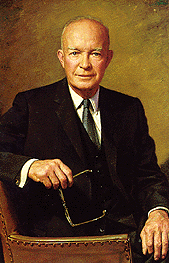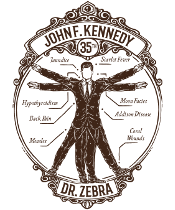

Health and Medical History of President
Dwight EisenhowerLived 1890-1969
Health and Medical History of President
Dwight EisenhowerLived 1890-1969
1776-1783
1812-1815
1846-1848
1861-1865
1898-1899
1917-1918
1941-1945
1950-1953
1964-1975
1990-1991
2001-2021

| UNDER CONSTRUCTION |
After a few days of limiting his smoking, Eisenhower decided that counting his cigarettes was worse than not smoking at all, and he quit. He never had another cigarette in his life. ... Eisenhower was frequently asked how he did it; he replied that it was simple, all he did was put smoking out of his mind. It helped, he would add with a grin, to develop a scornful attitude toward those weaklings who did not have the will power to break their enslavement. He [remarked]: "I nursed to the utmost ... my ability to sneer."
One day a White House visitor noticed the President was wearing leather bandages on his left wrist. When Ike explained that he had a mild arthritic condition there, the visitor said he was glad it wasn't serious. "I should say it is serious!" exclaimed Ike indignantly. "It means that I can't play golf!"Was this a manifestation of his Crohn disease?
Eisenhower ascribed the initial symptoms of his heart attack to onions he had eaten. This is not surprising: he loved onions and garlic, and ordered the White House cook to serve them in a small side dish 7a.
By 1:00 am on June 9, the 4 consulting surgeons unanimously felt surgical intervention was indicated. (However, the consultants had to be browbeaten into this consensus! See below.) Distention of the small bowel, seen on the initial x-ray, was increasing. At 2:20 am the President was induced and intubated and the operation began. Electrocardiographic observations were made during the 2 hour procedure.
At operation, the terminal 30 to 40 cm of the ileum had the typical appearance of chronic "dry" regional enteritis. The bowel immediately proximal to this was greatly dilated, moderately edematous, but pink. An ileotransverse colostomy was performed, bypassing the obstruction. The procedure was uneventful; 500 cc of blood were given.
The post-operative course was smooth as well, save for a fever and minor wound infection on the 11th post-operative day. He began conducting official business on the fifth post-operative day. 1
This episode illustrates one of the cardinal perils in delivering medical care to the President.
After remaining in seclusion for 3 days, Eisenhower returned to work, his speech not yet back to normal. To some, the press coverage of his difficulties in this period seemed "unnecessarily savage and sadistic," since some reporters seemed to be counting the number of goofs Eisenhower made during a press conference. But unlike the 1955 heart attack and the 1956 abdominal operation, the 1957 stroke occurred at a time when important presidential meetings were scheduled MORE 6a.
(Between his first infarction in 1955 and the April 1968 infarct, he had suffered two additional infarcts. Thus, the August 1968 event was his seventh myocardial infarction.)One of the most remarkable and fortunate things about all this is that although he was unconscious a number of times his intellectual functions, memory, and recall and interest in current events were not compromised. His energy reserve was low, however, so his activity was restricted to three periods of 45 minutes out of bed each day. His morale and spirits were magnificent considering all he had been through. 2 MORE
One day, the call came. A retired general was hospitalized in Walter Reed Army Medical Center. He had a history of multiple infarcts and was now end-stage. The IABP scientists were all ready to go, until they found out the general was Eisenhower. They declined the opportunity because they worried that if the IABP failed in him, it would permanently ruin the future prospects of the device.
- Eisenhower wanted small pillows to fit under his neck while he slept 7c. Whether this was mere habit, or indicative of neck problems is unknown.
- Eisenhower was bald. The first time he met his future Secretary of the Treasury, George Humphrey, Ike said to the balding Humphrey as he walked into the room: "George, I see you comb your hair the way I do." 5b
- Eisenhower was born David Dwight Eisenhower, but later reversed his first two names. 9a
- The extroverted Mrs. Eisenhower had a heart condition dating from childhood. She seemed fragile during her husband's presidency, spending much time in bed. "Social gatherings usually turned into a torment with headaches, asthma, weakness. and the [sic] inner ear trouble, which made her feel dizzy." Her inner ear difficulty led to abnormalities in her gait that sparked rumors she drank excessively. "The day of a party, she had to go to bed and stay there till the last minute." The staff referred to her as "Sleeping Beauty" because of her extensive time in bed. 7d
- Heaton, LD; Ravdin, IS; Blades, B; Whelan, TJ. President Eisenhower's operation for regional enteritis: a footnote to history. Annals of Surgery. 1964;159:661-666.
a p.664
- Hughes, CW; Baugh, JH; Mologne, LA; Heaton, LD. A review of the late General Eisenhower's operations: epilog to a footnote to history. Annals of Surgery. 1971;173:793-799. Pubmed: 4933301.
Comment: Hughes mentions plans to incorporate the General's medical history into book form for the National Archives.
- Pillsbury, DM. General Eisenhower's "melanoma". Journal of the American Academy of Dermatology. 1981;4:631-632. Pubmed: 7016937.
Comment: Also in: Nero, F. Conversations with the President. Buffalo, NY: Westwood Pharmaceuticals, 1978, volume 1, pp. 13-14.
- Ambrose, Stephen E. Eisenhower: Volume One: Soldier, General of the Army, President-Elect: 1890-1952. New York: Simon and Schuster, 1983.
a p.488
- Boller, Paul F. Jr. Presidential Anecdotes. New York: Oxford University Press, 1981.
 a p.298 b p.291
a p.298 b p.291 - Kucharski, A. Medical management of political patients: the case of Dwight D. Eisenhower. Perspectives in Biology and Medicine. 1978;22:115-126. Pubmed: 104273.
a p.123 b p.118
- Parks, Lillian Rogers. My Thirty Years Backstairs at the White House. New York: Fleet Publishing, 1961.
a p.325 b pp.331-332 c p.94 d pp.24-25, 321
Comment: This book stayed on the New York Times best-seller list for 26 weeks, prompting Jacqueline Kennedy to require all staff at the White House to sign a pledge agreeing not to write about their experiences (NY Times, page B8, Nov. 12, 1997). Parks's mother, a maid at the White House from 1909-1939, had actually been encouraged by Eleanor Roosevelt to write and publish a memoir (p260).
- Ginzberg, E. Ten encounters with the US health sector, 1930-1999. JAMA. 1999;282:1665-1668. Pubmed: 10553794.
- Montgomery-Massingberd, Hugh (ed). Burke's Presidential Families of the United States of America. 2nd ed. London: Burke's Peerage Limited, 1981.
 a p.515
a p.515Comment: Maps -- in great detail -- the ancestors and descendants of American presidents through Ronald Reagan. They would have had an exhausting time with President Obama's family tree! MORE







